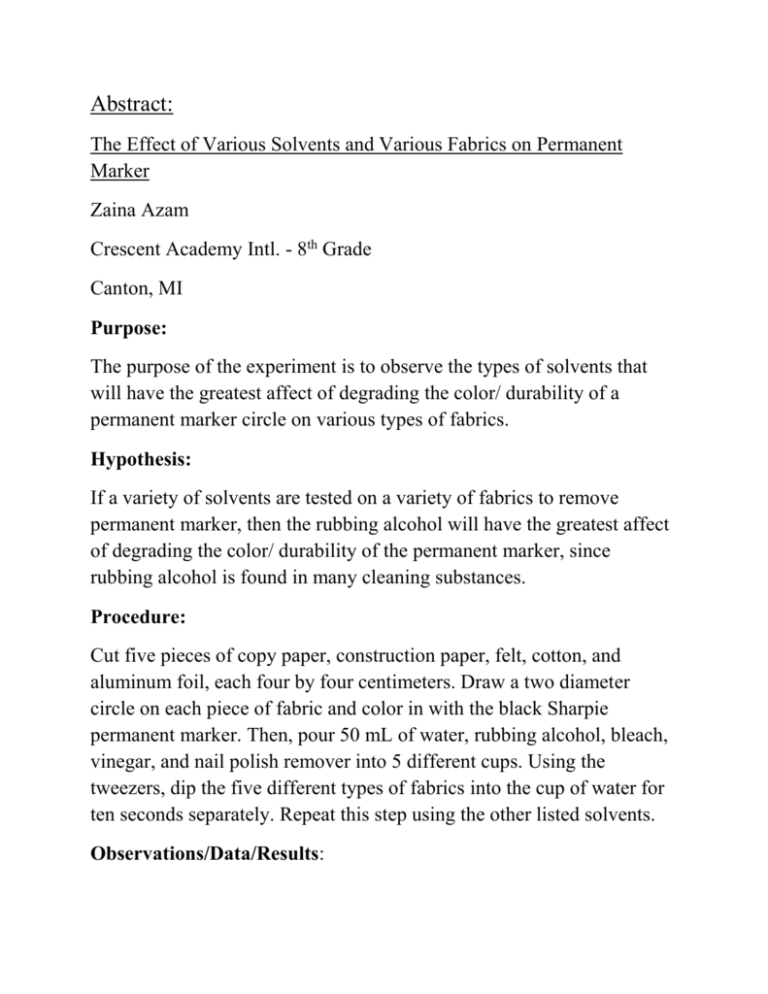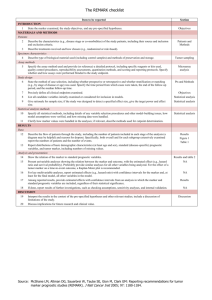science fair poster edition info
advertisement

Abstract: The Effect of Various Solvents and Various Fabrics on Permanent Marker Zaina Azam Crescent Academy Intl. - 8th Grade Canton, MI Purpose: The purpose of the experiment is to observe the types of solvents that will have the greatest affect of degrading the color/ durability of a permanent marker circle on various types of fabrics. Hypothesis: If a variety of solvents are tested on a variety of fabrics to remove permanent marker, then the rubbing alcohol will have the greatest affect of degrading the color/ durability of the permanent marker, since rubbing alcohol is found in many cleaning substances. Procedure: Cut five pieces of copy paper, construction paper, felt, cotton, and aluminum foil, each four by four centimeters. Draw a two diameter circle on each piece of fabric and color in with the black Sharpie permanent marker. Then, pour 50 mL of water, rubbing alcohol, bleach, vinegar, and nail polish remover into 5 different cups. Using the tweezers, dip the five different types of fabrics into the cup of water for ten seconds separately. Repeat this step using the other listed solvents. Observations/Data/Results: There were no changes for the permanent marker circles when dipped in water. The rubbing alcohol produced an effect for all the fabrics except for the aluminum foil. It caused the marker to disperse throughout the fabrics. The bleach whitened all the fabrics, turned the permanent marker circles brown, and had no effect on the size/shape of the circles. The vinegar didn’t produce any effects on the permanent marker circles. The nail polish remover produced an effect on all fabrics except aluminum foil and caused the marker to disperse throughout the fabrics. Conclusion: Alcohol-based substances, such as the rubbing alcohol and nail polish remover, were able to have the greatest effect in removing the permanent marker circles because the Sharpie marker is alcohol based; the alcohol substance in the rubbing alcohol and in the nail polish remover were able to mix with the alcohol in the ink, thus removing it. Water didn’t produce an effect on the permanent marker circle because Sharpie, along with many other permanent markers, is water resistant. Vinegar didn’t work because its main ingredient is acetic acid, which isn’t as effective. Question: How Permanent Are Permanent Markers? Hypothesis: If a variety of solvents are tested on a variety of fabrics to remove permanent marker, then the rubbing alcohol will have the greatest effect of degrading the color/ durability of the permanent marker, since rubbing alcohol is found in many cleaning substances. Variables: Independent Variable: The independent variables are the types of solvents and the types of fabrics (that will be affecting the permanent marker circle). Dependent Variable: The dependent variable is the durability/ color of the permanent marker. Background Research: Permanent markers, such as the classic Sharpie, are made up of three main ingredients. The three main ingredients are colorant, carrier (solvent), and resin. (Allison, page 1). A colorant is what gives a permanent marker its permanence and color. “Pigments do not fade like dyes nor do pigments bleed through paper.” (Allison, page 1). A dye is a coloring material that is dissolved in a solvent, such as water, to become a water soluble substance. On the other hand, a pigment is an insoluble substance. “Technically, a permanent marker need only meet these two qualifications to be considered permanent: it must use dyes or pigments, and it must adhere to most surfaces and/or be water resistant.” (Devlin, page 1). Solvents are used as the carrier in permanent markers. Resin is a substance that adds the “adhesion” substance to the permanent marker. The resin sticks like glue to most surfaces that the permanent marker is written on, which causes the pigment to attach to various surfaces. Due to this adhesion, permanent markers can be used to write smoothly on hard or soft surfaces. The resin also forms a film once the alcohol has evaporated, which is another factor that allows permanent markers to write uniformly on smooth or hard surfaces. (Allison, page 1). “There are effective ways to remove ink from permanent markers. Alcohol will remove permanent marker more effectively from nonporous materials, but it will work with porous materials as well.” (Devlin, page 1). Permanent markers aren’t very permanent on most surfaces. They can be removed with high pressure cleaning or with solvents such as acetone. They can also be removed by using a substance with the same ingredient that was in the permanent marker in the first place, which was alcohol. Substances, such as rubbing alcohol or nail polish remover. This breaks down the pigment and also allows the coating to decay. “Some permanent markers, however, are designed to be longer lasting.” (“Permanent Marker”, page 1). These permanent markers have two specialties; they are not able to fade away and they are able to resist some solvents. Permanent marker stains can be easily removed from glossy surfaces, such as glass. Since the ink is based on alcoholic substances, the stain can be removed using rubbing alcohol. In most cases, alcohol is very effective on non-porous surfaces. Permanent marker stains that have dried for more than several hours can be removed using acetone. However, acetone may damage the surface material. (Aguirre, page 1). Materials: The materials used were: 1. Five plastic cups 2. One black Sharpie permanent marker 3. One measuring cup (1000 mL/ 1 quart measuring cup) 4. Solvents (50 mL of each): a. Water b. Rubbing alcohol c. Bleach d. Vinegar e. Nail Polish Remover 5. One pair of tweezers or tongs 6. Paint Sample Papers (in the colors of brown, black, and blue) 7. A compass or penny 8. Fabric materials (five pieces of each, each four by four centimeters) a. Copy paper b. Construction paper c. Felt d. Cotton e. Aluminum foil 9. A ruler (with centimeters) 10. A timer or clock 11. Tape 12. Twenty-five labels for each trial (for the five different solvents and the five different fabrics) 13. 14. Counter or table space A camera Procedure: The experimental procedure is: 1. Cut five pieces of all the fabrics (copy paper, construction paper, felt, cotton, and aluminum foil), each four by four centimeters. 2. Draw a small dot/circle (2 centimeters in diameter) using a compass or the size of a penny with permanent marker on each of the twenty-five pieces of fabric. The circle should be drawn in the middle of the fabric (2 cm from the left and 2 cm from the bottom). 3. Color in the circle, making sure that no part of the fabric is showing inside the circle. 4. Using the 1000 mL/ 1 quart measuring cup, measure 50 mL, or ¼ cup, of all solvents (water, rubbing alcohol, bleach, vinegar, and nail polish remover) and pour the solvents in five different cups. Wash the measuring cup thoroughly between each solvent. 5. Label the plastic cups with the type of solvent that is in each cup. 6. Using the tweezers/ tongs, dip the five different types of fabric into the cup of water one at a time for ten seconds each. 7. After removing the fabrics from the cup of water, set the fabrics on a flat surface, preferably a table or counter, to dry for at least 12 hours. 8. Repeat steps five and six using rubbing alcohol, bleach, vinegar, and nail polish remover separately. 9. After 12-24 hours, observe and record results. 10. Clean up area. Safety Consideration: Bleach may cause irritations and burns. To prevent any injury or damage, wear gloves when handling, handle with caution, and wash hands after use. Data: This table represents the measurement of the permanent marker circle after it was dipped in the following solvents, the color of the permanent marker circle before it was dipped in the solvents, and the color of the permanent marker circles after it was dipped in the solvents (The paint sample papers are used here; they correspond with the number on the columns of “Color of Circle Before Dipped in Solvent” and “Color of Circle After Dipped in Solvents”). Round Fabric + Solvent 1a Copy Paper + Water Copy Paper + Rubbing Alcohol 1b Color of Circle Before Dipped in Solvent 610: Nightfall 610: Nightfall Color of Circle Measurements After Dipped in After Dipped Solvent in Solvent 610: Nightfall 2 cm diameter 609: Black Tea (black circle) 643: Smokestone (smudge on paper) Horizontal: 3.5 cm Vertical: 4 cm 1c 1d 1e 2a 2b 2c 2d 2e 3a 3b Copy Paper + Bleach Copy Paper + Vinegar Copy Paper + Nail Polish Remover 610: Nightfall 610: Nightfall 610: Nightfall 617: Firewood 2 cm diameter 610: Nightfall 2 cm diameter 609: Black Tea (black circle) 643: Smokestone (smudge on paper) 610: Nightfall Horizontal: 2.2 cm Vertical: 3.1 cm Construction Paper + Water Construction Paper + Rubbing Alcohol 610: Nightfall 609: Black Tea (black circle) 643: Troubled Sky (smudge on paper) 618: Landmark Brown Horizontal: 3 cm Vertical: 3.5 cm Construction Paper + Bleach Construction Paper + Vinegar Construction Paper + Nail Polish Remover 610: Nightfall 610: Nightfall 610: Nightfall 2 cm diameter 610: Nightfall 640: India Ink (black circle) 645: Great Lake (smudge on paper) Trial 1: Horizontal: 2.1 cm Vertical: 3.3 cm 611: Coalmine 2 cm diameter 610: Grand Tetons 2 cm diameter 610: Nightfall Felt + Water 610: Nightfall Felt + 610: Rubbing Nightfall 2 cm diameter 2 cm diameter 3c 3d 3e 4a 4b 4c 4d 4e 5a 5b 5c 5d Alcohol Felt + Bleach Felt + Vinegar Felt + Nail Polish Remover Cotton + Water Cotton + Rubbing Alcohol 610: Nightfall 610: Nightfall 610: Nightfall 609: Shaded Granite 611: Coalmine 2 cm diameter 612: Chimneysweep 2 cm diameter 611: Coalmine 611: Coalmine 611: Coalmine 2 cm diameter 612: Chimneysweep (black circle) 611:Smokestack (smudge on paper) 618: Landmark Brown 611: Coalmine Horizontal: 2.9 cm Vertical: 2.6 cm 612: Chimneysweep Horizontal: 2.1 cm Vertical: 2.2 cm 2 cm diameter 2 cm diameter Cotton + Bleach Cotton + Vinegar Cotton + Nail Polish Remover 611: Coalmine 611: Coalmine 611: Coalmine 2 cm diameter Aluminum Foil + Water Aluminum Foil + Rubbing Alcohol Aluminum Foil + Bleach Aluminum 610: Nightfall 610: Nightfall 610: Nightfall 612: Chimneysweep 2 cm diameter 610: Nightfall 612: Chimneysweep 2 cm diameter 610: 610: Nightfall 2 cm diameter 2 cm diameter 5e Foil + Vinegar Aluminum Foil + Nail Polish Remover Nightfall 610: Nightfall 612: Chimneysweep 2 cm diameter Conclusion: In conclusion, even though the permanent marker circles were not completely removed by the solvents, many solvents produced great effects of dispersing the marker throughout the fabric, removing a vast chunk of the circle, etc. Research shows that any alcohol based substances removed the permanent marker circle. Thus, the hypothesis was correct. The hypothesis was that the rubbing alcohol will have the greatest effect of degrading the color/ durability of the permanent marker on various types of fabrics because it is found in many cleaning substances. Results show that the rubbing alcohol and the nail polish remover were both the most effective in removing the black permanent marker circle from the fabrics. This is because since Sharpie permanent markers are alcohol based, the alcohol substance in the rubbing alcohol and in the nail polish remover were able to mix with the alcohol in the ink, thus removing it. The rubbing alcohol and nail polish remover had caused the permanent marker circles to disperse throughout the fabric, and this caused the original permanent marker circle to lose some of its color/ fade, causing it to turn a lighter shade of black. This is proof that the rubbing alcohol and the nail polish remover were the most effective in removing the permanent marker circles. Water was the constant in the experiment. There were no major changes in any of the fabrics dipped in the water. This is because Sharpie, along with most other permanent markers, is water resistant. The bleach had whitened all of the fabrics. It had also turned the permanent marker circles a brownish color. The circle on the felt that was dipped in bleach started to fade away, however it didn’t produce a major effect on removing the permanent marker circle. The vinegar didn’t produce a great effect on removing the permanent marker circles because the main ingredient in vinegar is acetic acid, which isn’t as effective as alcohol in removing permanent markers. Overall, permanent markers are not permanent, but it depends on the type of surface the permanent marker is on. If the permanent marker is on an easy-to-remove surface, one can rub rubbing alcohol onto it and it will vanish. This relates to how bad attitudes and misfortunes aren’t permanent. If one perseveres, one may rid the negative attitude and adapt a positive attitude. This makes one a step closer to moralization and a step closer to self-actualization. To be selfactualized, one must help others fulfill their needs so that others may become self-actualized, as well. Also, positive attitudes are contagious, so one can pass it on to others. This experiment also relates to the quote “What goes around, comes around” because it takes an alcoholic substance to remove an alcoholic substance. That means that if one has a negative attitude and doesn’t change it, a misfortune may be fallen onto them. In conclusion, permanent markers can be removed by alcohol based substances, as negativity can be overcome with perseverance. Bibliography: Allison, Keith. “What is in a Permanent Marker? E.g Sharpie (What are the Ingredients).” www.madsci.org. 29 August 2005. 27 January 2010. <http://www.madsci.org/posts/archives/200508/1125342426.Ch.r.html> Author unknown. “Permanent Marker.” www.absoluteastronomy.com n.d. 31 January 2010. <http://www.absoluteastronomy.com/topics/Permanent_ma rker> Devlin, Emily. “Why Are Permanent Markers Permanent?” www.ehow.com n.d (Copyright 1999-2010 eHow, Inc.). 26 January, 2010. < <http://www.ehow.com/about_5385482_permanentmarkers-permanent.html> Aguirre, Sarah. “Removing Ink Stains.” www.housekeeping.about.com. October 2009. 2 February 2010. <http://housekeeping.about.com/od/stainremoval/a/inkstain s.htm>






